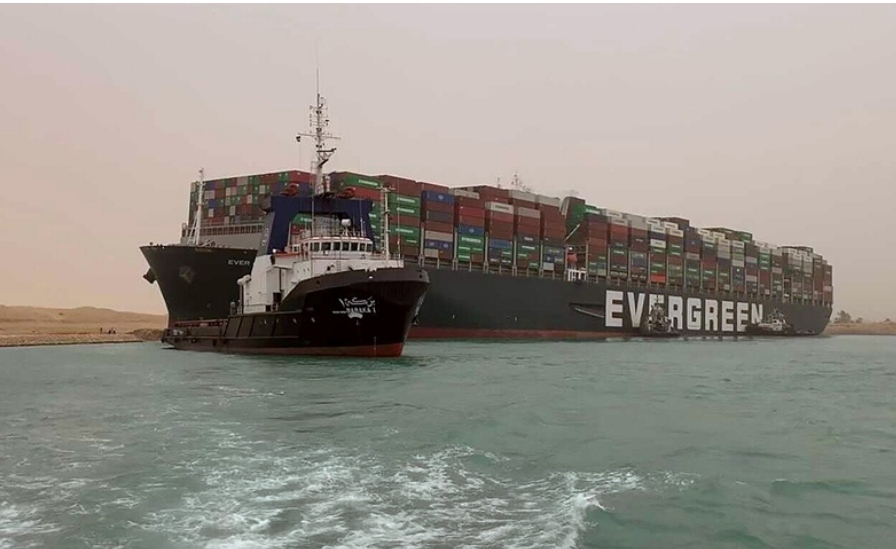The Suez Canal Crisis : A Lesson For Indian Defence Planners

Cargo Ship Ever Given
By
Colonel Awadhesh Kumar, Special Forces, Veteran
Logistics companies and shipping agents world over, are closely watching the worst shipping jam in years in the Suez Canal after a super-sized containership from the island of Taiwan ran aground in the middle of the vital waterway. Interestingly most of the crew of this Ship are Indians.
Every one is worried about a prolonged blockage that could result in massive consequences for the global supply chain. The time frame for the Canal to be cleared is still not clear but the worst-case scenario suggests it could take weeks, and there’s already a shipping jam of more than 100 vessels there on either side.
The Suez Canal Authority have temporarily suspended all navigational activities. Though bypassing the southern tip of Africa may not cost much extra money, as the extra fuel cost will be almost the same as the toll that the canal authority charges. However the real difference lies in the extra week’s time for the extra distance.
It has been reported that work to dislodge the 400-meter, 224,000-ton Ever Given slowed overnight Wednesday due to a low tide, and that ship-tracking data showed the position of the mega containership had only made minor changes over the past 24 hours.
The impact of this jam would be definite and global. For example Ukraine-origin grain bound for China will have to be re-routed via Cape of Good Hope if the blockage can’t be resolved quickly. That will take more time and cost more money. The flow of goods between China and Europe may be affected, and this will provide an opportunity for the operators of the China-EU cargo train service to hike rates.
The Suez Canal in Egypt is one of the world’s busiest shipping channels for goods, oil, grain and other products linking Asia and Europe. About 12 percent of total global trade of all goods goes through the vital waterway. It is estimated that one-tenth of last year’s traffic volume in the Canal, or 1,900 ships, were Chinese ships.
After an overnight surge, global crude prices receded as concerns over weakened demand from tighter pandemic controls in Europe weighed in. A Bloomberg report says that the blockage is costing $400 million an hour and crude tankers carrying 13 million barrels could be affected. This is the most important waterway, in which every country has a big stake, a prolonged blockage will have unimaginable consequences.
Imagine, if one grounded Ship in Suez can cause so much worry to the Chinese economy then what can happen to China if all the trade lanes passing through the Indian Ocean Region and going to China are blocked by India during any conflict even if it is like the Galwan Valley clashes.
So this incident must come as an eye opener to the Indian Defence Planners right from the Cabinet Committee Security down the Chain to Raksha Mantri, the Chief of Defence Staff, the three Services Chiefs HQ IDS and the three Services HQ.
Yes, We do need to strengthen our defences in the Himalayas but now priority must be given to the Indian Ocean Region. As a start, We need to establish a Maritime Theatre immediately comprising Southern Naval Command, Eastern Naval Command ( less Bengal Naval Area and Orissa Naval Area ), Andaman & Nicobar Command, Southern Air Command and ATTKK Area. Later a second Maritime Theatre should come up as South Western Theatre comprising Western Naval Command, Southern Army Command, South Western Air Command and South Western Army Command.
Next the Navy needs to be given priority for equipping with initial aim of sea denial and later full domination and Sea Control. Towards this end the following will be required to be provided to the Navy within this decade itself :
- 6x nuclear powered attack submarines
- 2x SSBN ( 15000 ton )
- 12x Diesel Electric Submarines
- 12x P8I LRMR aircrafts
- 12x MRMR aircrafts
- 4x Destroyers ( 12000 tons ) in addition to Vishakhapatnam Class
- 8x Frigates in addition to Nilgiri Class
- 16x Missile corvettes in addition to what has already been sanctioned
- 12x Mine clearing Vessels
The above additions will really make the Indian Navy a formidable force. However the Chinese with their three to four aircraft carriers may feel like making some forays into the IOR for Force Projection. To match the PLAN in this area and to boost up the confidence of other littorals that India and the Indian Navy is fully capable to defend the IOR, there may be a need to provide our Navy with the third aircraft Carrier of 65000 tons. Money for this may have to be provided by the Government by cost cutting in other ministries.




